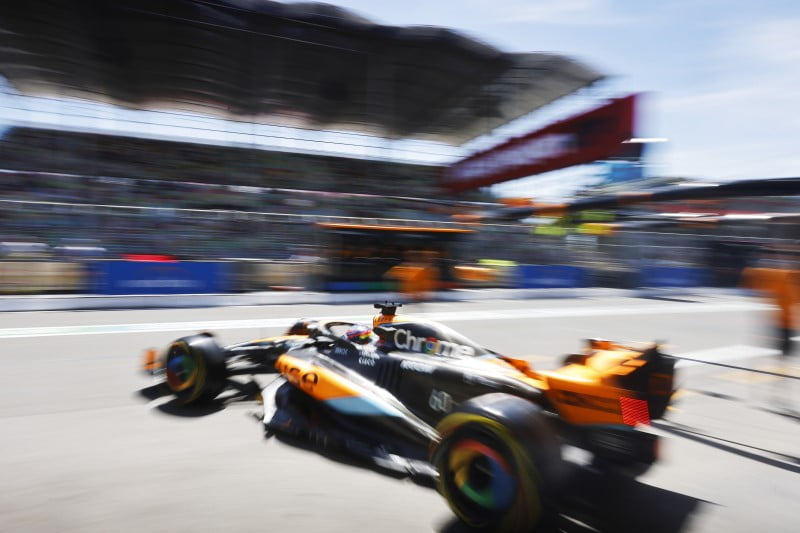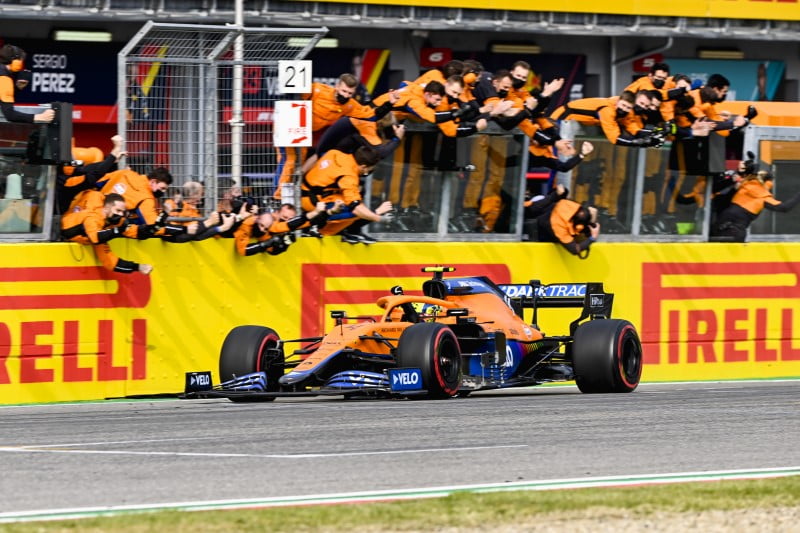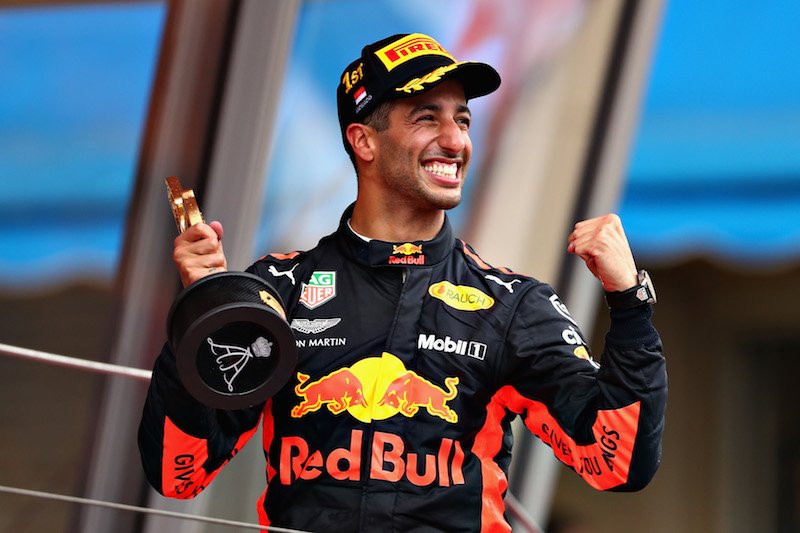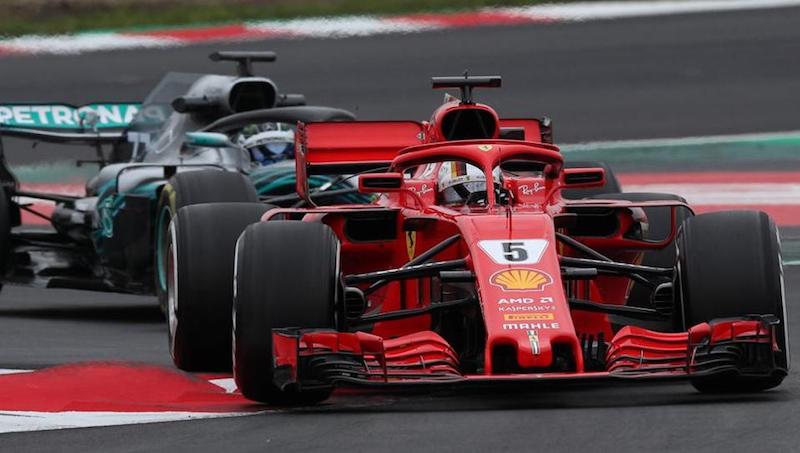2023 Azerbaijan Grand Prix
Budding Formula 1 tech-journalist Ashwin Issac pens his ‘F1 Midfield Tales’ from the 2023 Australian Grand Prix. ‘F1 Midfield Tales’ will be a combination of data and analysis that will aim to dissect the uber-competitive F1 midfield race-after-race.
Preface
After an unusually long pause In the Formula 1 calendar due to the cancellation of the Chinese GP, this respite was termed a mini-summer break. However, unlike the actual summer break, the teams at this time could work through the weeks to develop and understand their cars to optimize their performance.
When Formula 1 pitched its tent in the capital of the Land of Fire, every team was expected to bring in major updates and this expectation was surely satisfied by some teams.
The streets of Baku offer a unique experience in terms of entertainment to the fans and also in terms of the track layout for the drivers and teams. The quality of a race can be a hit-and-miss based on the racing history of this Grand Prix.
The layout of this street circuit contains a lot of 90-degree corners. It is a unique track in terms of setup where it could go in opposite directions, the teams could opt for a low drag configuration to maximize performance on these streets, especially on the last sector which consists of one of the longest straights in the calendar or a higher downforce configuration to maximize traction out of those 90-degree corners and in the tight and very influential middle sector a higher downforce setup also assists with tyre degradation.
This year there were no changes made to the track layout but more than 50% of the track was resurfaced. This created a relatively new unknown for the teams. This change was just an afterthought for the teams because a major change was made by the lawmakers of Formula One to the format of Sprint weekends.
The new format stated that on Friday there would be one free practice followed by a qualifying session for the main race. On Saturday, unlike the previous years, instead of a second free practice session, a Sprint shootout, which is a shortened qualifying session with mandated tires, in this case, medium tyres for Q1, medium tyres for Q2, and soft tyres for Q3.
This session determined the grid order for the following Sprint race on the same day and on Sunday there was the usual main race. What this meant was the spring shootout and the spring race itself became a standalone event that had no repercussions on the race, what this also spelled to the teams is that there would be only one practice session to set up their cars for the rest of the weekend. This turned out to be a challenge to the teams as the weekend progressed.
In this edition of the F1 Midfield Tales, the previously set narrative has changed let’s see how it develops as the weekend unfolded.
Observations
For the comparisons, data with similar variables are selected to make a viable analysis. For instance, the fastest sectors by a team and not individual drivers are considered for qualifying analysis. Lap times are collected for the same tyre compound at identical periods of the race.
Qualifying
The teams were, to say the least, not comfortable with the single practice session, and with the new tarmac, there were a lot of pre-race uncertainties.
The one-hour session of practice was marred by a red flag caused by a smoking Alpine on the track, Gasly’s car had a hydraulic leak and it caught fire and the session was further shortened due to other mishaps.
The teams went into the first qualifying session of the week, underprepared, with Alpine having virtually no run time with their new upgraded car.
- Sector 1
This sector of the track is a collection of 90-degree corners and short straights, which gives it a rear-limiting characteristic.
Here’s a bar chart comparing the times set by the fastest car of each team and the observations made are:
- McLaren with their new floor seemed to have a distinct advantage.
- The underprepared Alpine managed to do a decent job.
- Haas who optimized the car for a higher top speed by literally cutting out the upper plane of their rear wing, struggled a lot in this sector on the soft tyres.

- Sector 2
This sector which meanders through the old city is a highly demanding technical part of the circuit. Teams with a higher downforce setup make a lot of time in this section.
- The McLaren was again the best team in this sector.
- Haas and Alfa Romeo shed a lot of lap time.
- The trailing Alpha Tauri has made significant improvements from how they performed in Australia.

- Sector 3
Sector 3 starts just before the ever-crucial turn 16. The exit from that corner dictates the time you make or break until the finish line.
- McLaren is known to have an aerodynamically inefficient car where it produces a lot of ‘dirty’ downforce and it is evident with the lack of top speed and pace in this part of the circuit.
- The Alfa Romeo fared even worse in this sector.
- The ever-slippery Williams was the fastest car in the midfield in this section.

Carrying on from the analysis above to further understand the characteristics of each car, here is a mini-sector comparison of all the midfield teams. The graph below gives a visualization of each team’s advantages at different segments of the track.
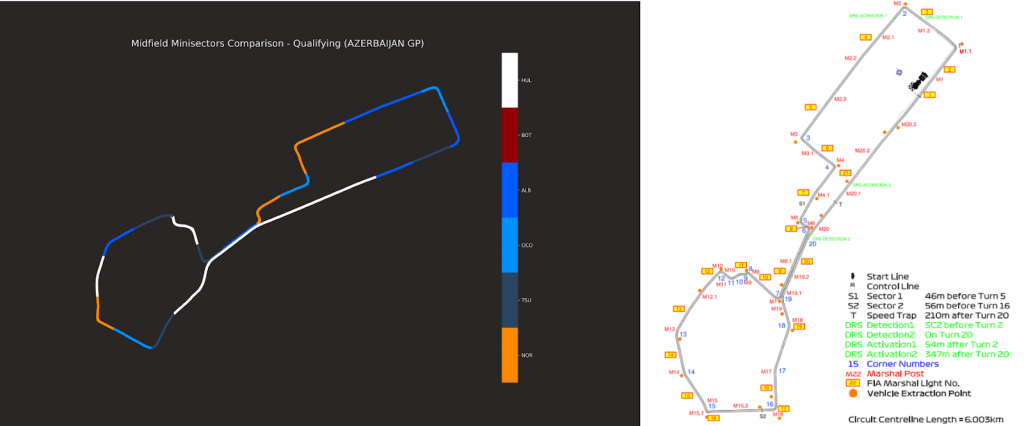
Sprint Shootout
This newly introduced session, which was very early in the day, had a few outliers.
- McLaren confirmed their pace with another good session, the change in conditions and the medium tyre didn’t affect their performance.
- The Alpha Tauri surprisingly lost a lot of pace, they just couldn’t get the medium tyres to work for them.
- Williams and Haas had a relatively better session compared to the qualifying session.
- Alfa Romeo were consistent in their lack of performance.
The sector times of the teams are compared in the charts below:



Sprint
The choice of tyres by the teams for the sprint was medium tyres. There were standouts in Norris, Ocon, and Bottas who bolted on soft tyres.
The race suffered an early safety car due to the debris and a tyre carcass on track from the car of Yuki Tsunoda after a coming together with his teammate and the wall at turn 13.
For a fair comparison lap times from the 7th lap have been taken into consideration.
- Initially, McLaren and Williams had great pace and maintained it throughout the race.
- The Haas of Magnussen was just off the pace but as the sprint progressed he was consistently faster than the McLaren and Williams.
- De Vries, Zhou and Gasly struggled for pace early but closed the gap in lap times latter in the session
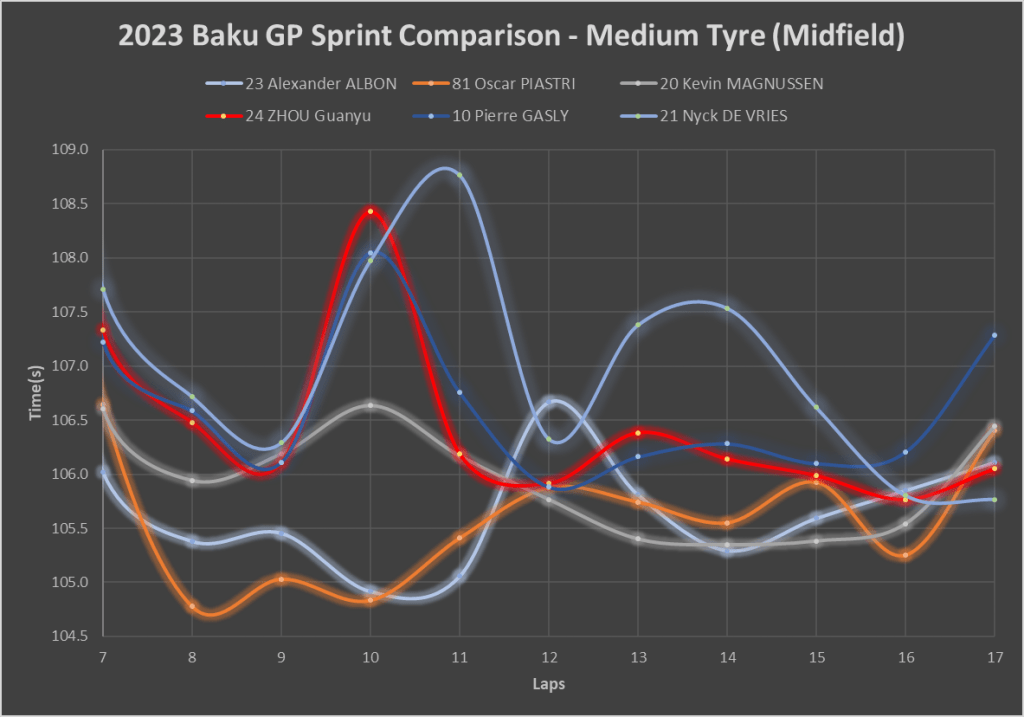
The soft tyres for the sprint or in a race were a terrible choice and that was clearly evident with how the ones who opted for it ended up at the bottom of the classification.
Here is a chart depicting the same, a comparison between teammates on different tyres.
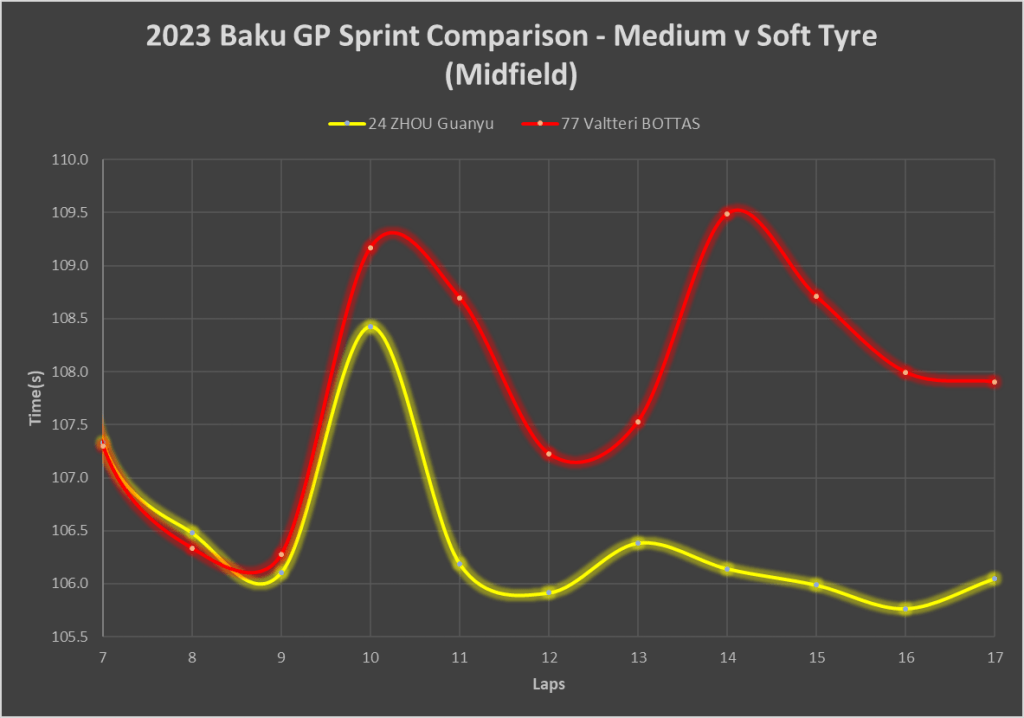
The Race
Apart from De Vries, Ocon, and Hulkenberg, every driver started on the medium tyres. This race was expected to be a one-stop race but the teams were still unsure because of the lack of long runs, their only data point was from the sprint. Teams were surprised with the wear rate of the medium tyres at the end of the sprint.
That wear rate seemed to be consistent even on race day and drivers were already struggling for grip on the 9th lap, Albon pulled the trigger by going into the pits first and other teams started to follow, but to their dismay, there was a safety car on the 11th lap courtesy of a stranded Alpha Tauri on De Vries who had broken his front left suspension after an encounter with the wall at turn 5. All the rest took advantage of this situation and darted into the pits to bolt on the hard tyres. These hard tyres would eventually last the rest of the race.
After this round of pits, there was nothing much to pick about because of the DRS train that formed behind the pit lane starting Ocon and Hulkenberg, they opted to stay out and went on to race on their hards until the last two laps, when they had to make their mandatory pit stops.
There was not much of a performance difference for the cars behind to make an overtake even with their DRS open. The change that Formula One made by reducing the DRS activation zone did not help the cause.
This resulted in all the cars posting very similar times, which is evident in the chart below.
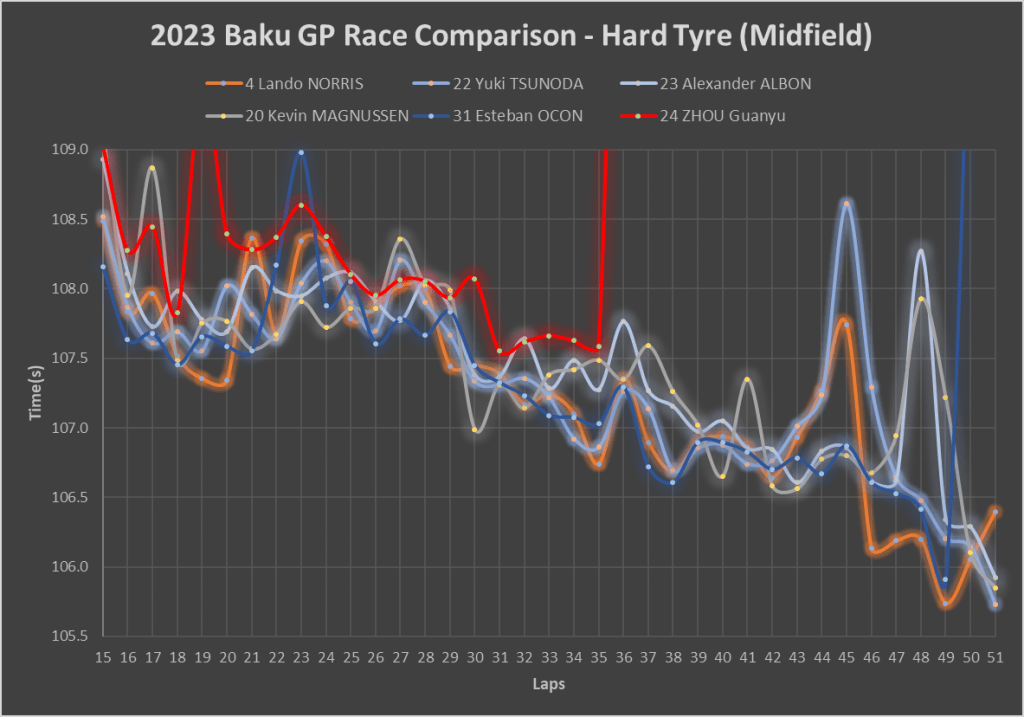
Conclusion
The Azerbaijan Grand Prix weekend was unfortunately not as exciting as it was expected to be.
The midfield was plagued by the DRS train and the true performance of the new upgrades brought by the team couldn’t be gauged.
Nevertheless, there were a few positive signs for a few teams, McLaren has made a few gains in their performance with their new floor. There are signs that the changes made have more performance to give.
Alpine had a weekend to forget where the circumstances didn’t allow us observers and more importantly, them to see the fruits of their hard work with their upgrades.
Alpha Tauri seemed to have taken a step in the right direction but their performance could well be track specific as historically they have performed well in the streets of Baku.
Haas came into Baku with a very track-specific car, which eventually did produce the results they looked for.
Alfa had nothing to cheer about this weekend as they never looked like a team that has taken a positive step, coming to a conclusion about their progress would be criminal.
We go back to a regular race weekend in Miami but it is a given that an event in the ‘Magic City’ will be anything short of extraordinary. That turnover time is short, no one is complaining about that this weekend.
Ashwin Issac is a budding Formula 1 tech-journalist. He has completed a Master of Science degree in Automotive Systems Engineering from Loughborough University, UK. He will pen his thoughts for the ‘F1 Midfield Tales’ section in 2023.
